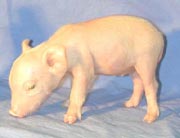 |
|
Also see: Today's
Top Stories
|
|
Science & Technology |
Cloned Pigs Modified for Use in Human Transplants
Two competing teams have cloned pigs
that have been genetically modified to produce organs more suitable for
transplantation into humans.
Pig organs are well suited for transplantation; they are approximately the same size as human organs and have similar plumbing, which makes reconnecting blood vessels much easier. Also, the size of pig litters tends to be large and pigs reproduce quickly, raising the prospect of a large supply of "spare" organs. |

Organ Donor?
Piglets are being genetically modified to lack a gene that contributes to tissue rejection when organs of another species are transplanted into people. Photograph copyright Science |
|||||||||||||
|
|
A problem with using pig organs, however, is that
they are coated with sugar molecules that trigger acute rejection in people.
Human antibodies attach themselves to these sugar molecules and quickly
destroy the newly transplanted pig organ.
To circumvent the rejection, scientists are working to produce pigs that lack the sugar-producing gene. In a significant step toward that goal, a team of scientists led by Randall Prather of the University of Missouri in Columbia created four cloned piglets in which one copy of the sugar-producing gene was "knocked out" (an organism receives two copies of a gene, one from the mother and one from the father). The piglets were born in September and October. A description of the work was published online by the journal Science. Earlier this week, PPL Therapeutics PLC of Scotland, the company that helped clone Dolly the sheep, announced the birth of five cloned piglets that also lack a copy of the sugar-producing gene. The piglets were born December 25 and were named Noel, Angel, Star, Joy, and Mary. By selectively breeding the experimental pigs, both teams of scientists hope to produce pigs lacking both copies of the gene. It's expected that the organs of these modified pigs could be transplanted into people without the problem of tissue rejection. The new results are a significant advance over many other attempts at genetic modification in animals because in both of the studies, the scientists were able to modifyóin this case, "knock out"óa gene at a specific location. Although genes from other organisms have been inserted into the genomes of sheep, cattle, and pigs, scientists have had little control over where on a chromosome the new gene is incorporated. "This is the first time a specific genetic modification has been made in the pig," said Prather. Prather's team at the University of Missouri and his colleagues at Immerge BioTherapeutics Inc. in Charlestown, Massachusetts, genetically altered fetal pig cells, which were used to create embryo clones. Of 3,000 genetically modified pig embryos that were implanted into 28 surrogate sows, only seven piglets were born, three of which died later. The cloning of Dolly almost five years ago raised expectations of creating identical, genetically modified organs for transplantation into humans. The cloning of genetically modified piglets brings scientists closer to their goal of "xenotransplantation"óthe transfer of cells and organs from one species into another. A concern that has dampened the prospects of xenotransplantation is the possibility of spreading viruses from one species to another. Porcine endogenous retrovirus (PERV), for example, is part of a pig's natural genetic makeup and does not cause any disease in the animal. There is no guarantee, however, that PERV would be harmless in humans. To minimize the risk of spreading PERV, Prather's team used a line of pigóminiature swineóthat was developed specifically for the purpose of transplantation. A major advantage of these pigs is that they are unable to spread PERV. Prather's team expects to produce a miniature swine that lacks both copies of the sugar-producing gene within the next 18 months. National Geographic Today, 7 p.m. ET/PT in the United States, is a daily news magazine available only on the National Geographic Channel. Click here to request it. |
|
|||||||||||||||||||
|
Write the Editor | Masthead | nationalgeographic.com E-mail Updates | Press Releases | Privacy Policy More to see at nationalgeographic.com |